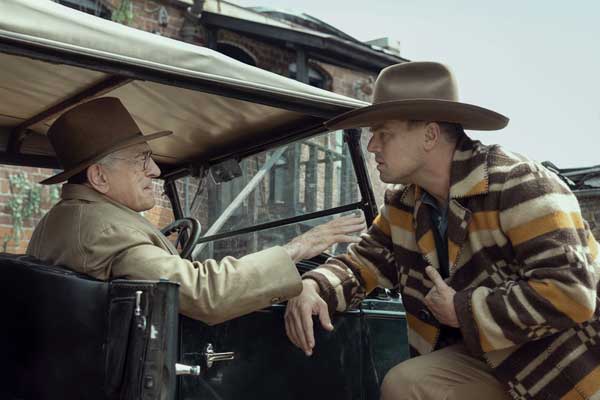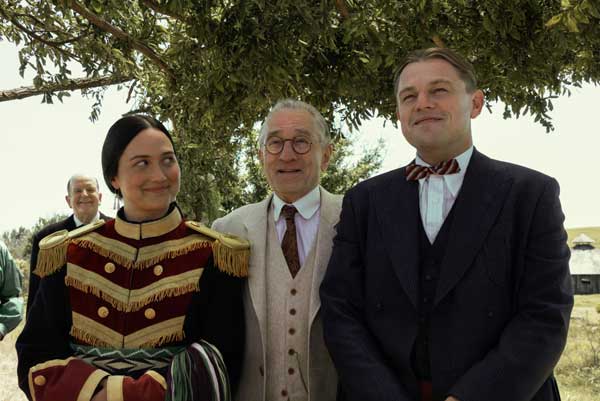|
The
first fictional
portrayal of the Osage
murders, which were
committed in Oklahoma
in the 1920s, was a
1932 broadcast of The Lucky Strike Hour that Martin Scorsese recreates toward the end of his film, Killers
of the Flower
Moon. Scorsese—who
plays the announcer in
that bit—uses it
to reveal the later
lives of the
perpetrators and
survivors of the
crimes. It is plain in
context of the
broadcast that the
victims—and,
even more, their
ethnic
identities—are
an afterthought in a
radio show whose
obvious purpose is to
glorify the Federal
Bureau of
Investigation and its
director,
J. Edgar Hoover.
The Osage murders also
figured in a
perfunctory vignette
in Mervyn LeRoy's 1959
movie, The FBI Story, starring James Stewart as an FBI
agent. That
film provides details
of a few of the
murders—those of
Henry Roan and Bill
and Reta
Smith—and a few
scenes of Indians
driving or being
chauffeured in fancy
cars around oil
rigs. Otherwise,
neither the portrayal
of the murders nor the
rest of the film offer
anything of interest
except for those who
worship Hoover, who
had script approval.
Scorsese's film is
based on the
enthralling 2017 book
by David Grann, which
is subtitled "The
Osage Murders and the
Birth of the
FBI." Written as
a whodunit, Grann's Killers of the Flower Moon recounts
the murders in
parallel with the
story of Tom White,
the agent who
supervised the
investigation, and the
growth of the agency
under Hoover's
Machiavellian
eye.
Scorsese—who
co-wrote the movie's
screenplay with Eric
Roth—includes
White (played by Jesse
Plemons) in the story,
but only in its last
third.
Scorsese's film is a
whydunit, and the
"why" is tragically
plain: greed
compounded by racism.
In the early 1870s the
Osage were forced off
their ancestral lands
onto a barren
reservation in
Oklahoma that, in the
early 20th century,
was discovered to have
some of the richest
oil deposits in the
U.S. By 1923 the
tribe was earning more
than $30 million
annually from the oil,
and all its enrolled
members were entitled
to munificent
quarterly dividend
checks. However,
the money had strings
attached.
Because the government
did not regard the
Osage as competent to
manage their own
money, it appointed
white "guardians" to
oversee its
management. It
became common for
these guardians to
intermarry with the
Osage. It then
became common for
members of the tribe
to turn up
dead—and for
their white spouses
and in-laws to inherit
their oil rights.

Grann's Killers of the Flower Moon builds suspense by presenting the story
through the prism of White's investigation. The reader comes gradually to
the horrific realization that all the nice, protective white guys in the oil
town of Pawhuska—such as William "King" Hale and his nephew Ernest
Burkhart—were in fact serial killers. But in preparing his movie,
Scorsese—especially after conferring with leaders of the Osage
Nation—concluded that constructing the story as a mystery was an injustice
to the victims, like telling the story of the Holocaust through the
perspective of the Nazis. Scorsese makes plain from the beginning that the
Osage were being murdered openly, without so much as a pretense of
investigating their deaths. A man writhes and froths at the mouth after
being given poisoned bootleg whiskey; a woman is shot in the back of the
head by her husband as she tends to their baby.
Some commentators have been dissatisfied with Scorsese's version because
it still places Hale and Burkhart—played by Robert De Niro and Leonardo
DiCaprio—front and center. A few have argued that, rather than Killers of
the Flower Moon, a film should have been made of Mean Spirit, the
Pulitzer-nominated 1990 novel about the Osage murders by Chickasaw
novelist Linda Hogan. However you stand in that esthetic and ethical
debate, there is no question that Scorsese's film is a monumental
achievement, arguably the greatest of his long career. One could argue that
three-and-a-half intermissionless hours are a lot to ask of an audience, but
Scorsese more than justifies that request through the film's narrative
sweep, the excellence of the dialogue and performances, and the
resplendent visuals as provided by cinematographer Rodrigo Prieto, editor
Thelma Schoonmaker, and production designer Jack Fisk. There is also a
superb music score by Robbie Robertson, who died shortly before the film's
release.
It was probably wise of Scorsese, from a sheer stylistic standpoint, not to
make Killers of the Flower Moon a straightforward mystery. His previous
attempt at one, the 2010 film Shutter Island, was not entirely successful
despite fine performances by DiCaprio and others. Scorsese's strength has
always been in creating an airtight world that imprisons his characters and
defines everything about their lives. All the elements of Scorsese's worlds
are there from the beginning; there is nothing to detect, except the ways in
which the consequences of his characters' machinations slowly close in on
them. Newland Archer in The Age of Innocence is just as trapped as Travis
Bickle in Taxi Driver or Henry Hill in GoodFellas. Their circumstances
and their basic personalities are the only differences. In Killers of the
Flower Moon, the circumstances are as hermetic, and as dire, as in any
previous Scorsese film. The suspense comes, in the case of Hale and
Burkhart, from watching the noose tighten around them as they inevitably
prove less clever than they thought they were. For Burkhart's wife Mollie
(Lily Gladstone), the situation is more perilous still: she innocently
continues to believe in her husband's honesty while he is embroiled in plots
to kill her relatives and to slowly poison her.

The actors in Killers of the Flower Moon—including many actual
Osage—are uniformly excellent; one standout in the supporting cast is Cara
Jade Myers as Mollie's sister Anna, a freewheeling flapper who becomes
one of the film's most poignant victims. The veteran Native Canadian
actress Tantoo Cardinal also has a moving final scene, the nature of which I
prefer for you to discover for yourselves. In the end, however, the film
focuses on the central trio of Burkhart, Hale, and Mollie. All three
characters are fascinating, as written and as played. De Niro's Hale is the
most archetypal—the amoral villain convinced of his own integrity and
good will. It goes without saying that Gladstone's Mollie is the most
sympathetic, but Gladstone keeps us fascinated by revealing Mollie's quirks
while keeping our focus on Mollie's decency. When she first meets
Burkhart, she doesn't bother to hide her amusement at his clumsy pickup
lines. Later, as her grief and peril grow exponentially, she tears our hearts
out. Yet Gladstone's finest moment is at the end, when—through the barely
perceptible movement of her eyes and facial muscles—Mollie shows she
has come to realize exactly who her husband is.
Part of Mollie's realization is that Ernest Burkhart will never come to terms
with who he is. As the novelist Jim Shepard points out in a recent New
York Times essay, this makes Burkhart a classic Scorsese antihero.
"Scorsese's movies have persistently left their protagonists in the semi
-disingenuous state of sitting clueless amid the rubble," Shepard writes; by
the end of Killers of the Flower Moon, Burkhart has created mountains of
rubble, literally and figuratively. Like Henry Hill, Burkhart loves the spoils
of his criminality, but sees himself as an innocent. He acts largely under
Hale's orders, and he believes that excuses him; he also believes that he
genuinely loves Mollie and their children, and he may actually do so. At
the end Burkhart's face bears the lumpen resentment of a not-too-bright
child caught stealing candy, and who believes he had a right to the candy
all along. He symbolizes not only the usual Scorsese protagonist, but the
entire history of White settlement of the West.
Appropriately, Scorsese begins and ends his film with Osage ceremonies.
Filling the screen with color and light, these ceremonies bear the emotion
of a people who were dealt a hideous injury that can never be redressed. Killers of the Flower Moon helps to correct the historical record, with
cinematic mastery that no viewer will soon forget. At least it is Mollie
Burkhart's story, and not J. Edgar Hoover's.
|